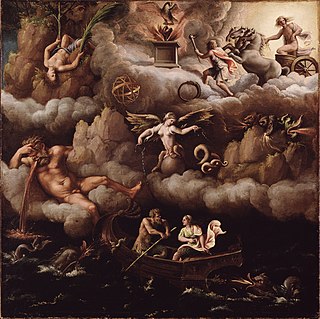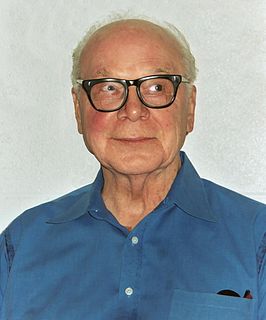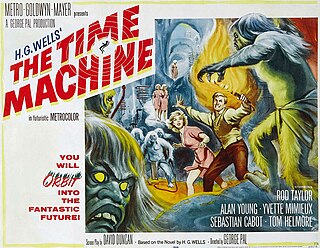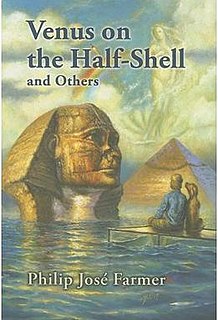Related Research Articles

Science fiction is a genre of speculative fiction which typically deals with imaginative and futuristic concepts such as advanced science and technology, space exploration, time travel, parallel universes, and extraterrestrial life. It has been called the "literature of ideas", and it often explores the potential consequences of scientific, social, and technological innovations.

Ursula Kroeber Le Guin was an American author best known for her works of speculative fiction, including science fiction works set in her Hainish universe, and the Earthsea fantasy series. She was first published in 1959, and her literary career spanned nearly sixty years, producing more than twenty novels and over a hundred short stories, in addition to poetry, literary criticism, translations, and children's books. Frequently described as an author of science fiction, Le Guin has also been called a "major voice in American Letters". Le Guin herself said she would prefer to be known as an "American novelist".

Revolt in 2100 is a 1953 science fiction collection by American writer Robert A. Heinlein, part of his Future History series.

A monster is a type of fictional creature found in horror, fantasy, science fiction, folklore, mythology and religion. Monsters are very often depicted as dangerous and aggressive with a strange, grotesque appearance that causes terror and fear. Monsters usually resemble bizarre, deformed, otherworldly and/or mutated animals or entirely unique creatures of varying sizes, but may also take a human form, such as mutants, ghosts and spirits, zombies or cannibals, among other things. They may or may not have supernatural powers, but are usually capable of killing or causing some form of destruction, threatening the social or moral order of the human world in the process.

Philip José Farmer was an American author known for his science fiction and fantasy novels and short stories.

Venus on the Half-Shell is a science fiction novel by American writer Philip José Farmer, writing pseudonymously as "Kilgore Trout", a fictional recurring character in many of the novels of Kurt Vonnegut. This book first appeared as a lengthy fictitious "excerpt"—attributed to Trout —in Vonnegut's God Bless You, Mr. Rosewater (1965). With Vonnegut's permission, Farmer expanded the fragment into an entire standalone novel. Farmer's story was first published in two parts beginning in the December 1974 issue of The Magazine of Fantasy and Science Fiction. The plot, in which Earth is destroyed by cosmic bureaucrats doing routine maintenance and the sole human survivor goes on a quest to find the "Definitive Answer to the Ultimate Question," was an inspiration for the plot of the later Hitchhiker's Guide to the Galaxy series.
The exploration of politics in science fiction is arguably older than the identification of the genre. One of the earliest works of modern science fiction, H. G. Wells’ The Time Machine, is an extrapolation of the class structure of the United Kingdom of his time, an extreme form of social Darwinism; during tens of thousands of years, human beings have evolved into two different species based on their social class.

Time travel is a common theme in fiction, mainly since the late 19th century, and has been depicted in a variety of media, such as literature, television, film, and advertisements.

Mundane science fiction (MSF) is a niche literary movement within science fiction that developed in the early 2000s, with principles codified by the "Mundane Manifesto" in 2004, signed by author Geoff Ryman and "The Clarion West 2004 Class". The movement proposes "mundane science fiction" as its own subgenre of science fiction, typically characterized by its setting on Earth or within the Solar System; a lack of interstellar travel, intergalactic travel or human contact with extraterrestrials; and a believable use of technology and science as it exists at the time the story is written or a plausible extension of existing technology. There is debate over the boundaries of MSF and over which works can be considered canonical. Rudy Rucker has noted MSF's similarities to hard science fiction and Ritch Calvin has pointed out MSF's similarities to cyberpunk. Some commentators have identified science fiction films and television series which embody the MSF ethos of near-future realism.
The Baháʼí Faith and related topics have appeared multiple forms of fiction. The mention of this religion can be seen in science fiction, fantasy, short stories, novelettes, novels, and TV series. In 2005, an estimated value of 30 references could be found relating Baháʼí Faith to different forms of fiction. An estimated 3rd of these references have a significant relationship with the religion in the way that these forms of fiction show the Baháʼí Faith as a crucial aspect of the story. The first occurrence known is perhaps in the writings of Marie von Najmajer wrote a poem dedicated to Tahirih in Gurret-úl-Eyn: Ein Bild aus Persiens Neuzeit which was published in 1874. After a series of works covering the events of the Bábí period, most of the focus shifted towards Baháʼí specific related connections. Soon Khalil Gibran wrote two books - The Prophet and Jesus, The Son of Man. There is some second-hand evidence for the sustained influence of ʻAbdu'l-Bahá in these works. In modern times the first known occurrence is of a short story by non-Baháʼí Tom Ligon The Devil and the Deep Black Void, - he also wrote a sequel The Gardener. The next fictional publication, in 1991, which references the Baháʼí Faith may be a short story "Home Is Where…" by Baháʼí Maya Kaathryn Bohnhoff,

Gilgamesh in the Outback is a science fiction novella by American writer Robert Silverberg, a sequel to his novel Gilgamesh the King as well as a story in the shared universe series Heroes in Hell. It won the Hugo Award for Best Novella in 1987 and was also nominated for the Nebula Award for Best Novella in 1986. Originally published in Asimov's Science Fiction, it was then printed in Rebels in Hell before being incorporated into Silverberg's novel To the Land of the Living. Real-life writers Robert E. Howard and H. P. Lovecraft feature as characters in the novella.
Jediism is a philosophy mainly based on the depiction of the Jedi characters in Star Wars media. Jediism attracted public attention in 2001 when a number of people recorded their religion as "Jedi" on national censuses.

Venus on the Half-Shell and Others (ISBN 978-1-59606-128-6) is a collection mostly of science fiction author Philip José Farmer's pseudonymous fictional-author literary works, edited by Christopher Paul Carey and published in 2008. Farmer describes a fictional-author story as "a tale supposedly written by an author who is a character in fiction." Carey, who had access to Farmer's correspondence while editing the book, reveals in his introduction that in the early to mid-1970s Farmer planned to edit an anthology of fictional-author stories by other writers. Farmer solicited fictional-author stories from authors such as Arthur Jean Cox, Philip K. Dick, Leslie Fiedler, Ron Goulart, Howard Waldrop, and Gene Wolfe, urging them to submit their stories to venues such as The Magazine of Fantasy and Science Fiction. Only Cox, Waldrop, and Wolfe completed their stories and had them published, although Philip K. Dick's never realized fictional-author story "A Man for No Countries" as by Hawthorne Abendsen is said to have led Dick to write his posthumous novel Radio Free Albemuth. In the end, Farmer's fictional-author anthology never materialized.

Typewriter in the Sky is a science fantasy novel by American writer L. Ron Hubbard. The protagonist Mike de Wolf finds himself inside the story of his friend Horace Hackett's book. He must survive conflict on the high seas in the Caribbean during the 17th century, before eventually returning to his native New York City. Each time a significant event occurs to the protagonist in the story he hears the sounds of a typewriter in the sky. At the story's conclusion, de Wolf wonders if he is still a character in someone else's story. The work was first published in a two-part serial format in 1940 in Unknown Fantasy Fiction. It was twice published as a combined book with Hubbard's work Fear. In 1995 Bridge Publications re-released the work along with an audio edition.

Satellite Science Fiction was an American science-fiction magazine published from October 1956 to April 1959 by Leo Margulies' Renown Publications. Initially, Satellite was digest sized and ran a full-length novel in each issue with a handful of short stories accompanying it. The policy was intended to help it compete against paperbacks, which were taking a growing share of the market. Sam Merwin edited the first two issues; Margulies took over when Merwin left and then hired Frank Belknap Long for the February 1959 issue. That issue saw the format change to letter size, in the hope that the magazine would be more prominent on newsstands. The experiment was a failure and Margulies closed the magazine when the sales figures came in.

The following outline is provided as an overview of and topical guide to science fiction:
Theological fiction is fictional writing which shapes people's attitudes towards theological beliefs. It is typically instructional or exploratory rather than descriptive, and it engages specifically with the theoretical ideas which underlie and shape typical responses to religion. Theological fiction, as a concept, is used by both theists and atheists, such as in fictional pantheons and cultures in theological fantasy literature.
References
- ↑ "1943: Gather, Darkness! By Fritz Leiber". SciFi Scentury. 19 July 2008. Retrieved 28 June 2015.
- ↑ "Philip José Farmer, The Best of Philip José Farmer (Subterranean Press, 2006)" . Retrieved 28 June 2015.
- ↑ Baker, Susan; Gibson, Curtis S. (1997). Gore Vidal: A Critical Companion. p. 24. ISBN 978-0313295799 . Retrieved 28 June 2015.
- ↑ Chorost, Michael (2005). Rebuilt: How Becoming Part Computer Made Me More Human . Houghton Mifflin Harcourt. p. 179. ISBN 9780618378296 . Retrieved 27 June 2015.
dune theocracy.
- 1 2 Klein, Sabrina; Tomlinson, Patrick S.; Genesse, Paul (July 2012). Eighth Day Genesis: A Worldbuilding Codex for Writers and Creatives. p. 245. ISBN 9780985825409 . Retrieved 27 June 2015.
- ↑ Camp, L. Sprague de (29 September 2011). Time and Chance: An Autobiography. Donald M. Grant, Publisher, Inc. ISBN 9781880418321 . Retrieved 29 June 2015.
- ↑ "The Stork Factor". orielisbooks.com. Retrieved 28 June 2015.
- ↑ Anderson, Poul (December 1975). "The Bitter Bread". Analog Science Fiction and Fact .
- ↑ Wagner, Thomas M. "Noninterference - Review". sfreviews.net. Retrieved 27 June 2015.
- ↑ "SYNOPSIS - VOYAGERS IV: THE RETURN". benbova.com. Archived from the original on 8 May 2015. Retrieved 27 June 2015.